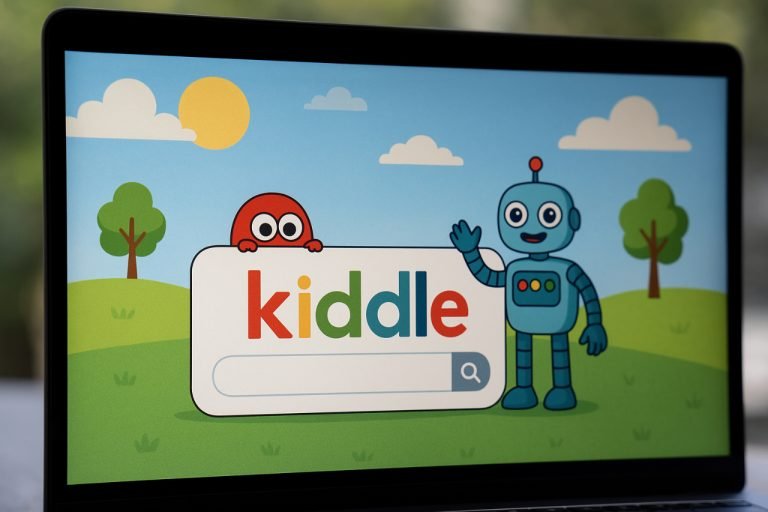Introduction
In today’s connected world, children encounter digital information earlier than ever before but not all of it is designed with their safety or understanding in mind. Kiddle, a visual search engine made specifically for kids, aims to bridge that gap. It creates a safe, simplified, and visually engaging environment for online exploration, using a combination of Google’s SafeSearch technology, proprietary filtering, and human moderation.
Parents, educators, and digital literacy experts increasingly view Kiddle as an essential tool in promoting responsible internet use among children. Rather than blocking the internet entirely, it empowers kids to learn self-guided research within a safe boundary. From homework questions to curiosity-driven exploration, Kiddle’s mission is to make the web child-friendly without stripping away discovery and creativity.
Beyond its core search feature, Kiddle’s Kpedia encyclopedia offers hundreds of thousands of kid-optimized articles, helping young users read about science, history, and culture in accessible language. As schools and families seek digital tools that combine education, safety, and usability, Kiddle stands out as a well-balanced approach though not without its limitations and debates over content filtering.
What is Kiddle and How Does It Work?
Kiddle is a child-friendly search engine designed to make internet exploration safer for young audiences. Built on top of Google’s Programmable Search Engine, it combines automated SafeSearch technology with human editorial filtering to remove explicit or inappropriate material. The platform offers search tabs for Web, Images News, and Videos, but all results are pre-screened for child-appropriate language and context. Its homepage, illustrated with a cartoon-style space theme, signals an environment built for curiosity and imagination rather than advertising or distraction.
Kiddle’s results are presented in a visual card format, showing larger images and easy-to-read summaries. The first few results are typically editorially written for children, while later ones may be safe general sources. This ranking structure is meant to balance accuracy, readability, and safety allowing kids to find educational content without stumbling onto adult material.
Behind the scenes, Kiddle employs multiple filtering layers: Google’s SafeSearch API, a keyword blacklist, and a manual curation process. Human reviewers regularly evaluate reported content and adjust filters accordingly. This hybrid system attempts to catch what automated tools miss while reducing the risk of “false positives” sites incorrectly blocked due to sensitive wording but non-harmful context.
What Makes Kiddle Different from Google’s SafeSearch?
While Google SafeSearch merely hides explicit results within Google’s main search, Kiddle goes further. It operates as a fully separate portal that re-orders, rewrites, and sometimes removes results entirely. SafeSearch is an algorithmic layer; Kiddle adds editorial intent. Its top results often come from rewritten articles targeted at younger readers, sometimes from educational publishers or Kpedia itself.
The distinction also lies in presentation. Google’s SafeSearch still shows snippets and ads in adult-oriented formats. Kiddle eliminates advertising, promotes visual summaries, and ensures reading levels align with early learning standards. Essentially, SafeSearch filters content visibility; Kiddle filters comprehension and context.
How Are Search Results Prioritized and Displayed for Children?
Kiddle ranks results according to child suitability and clarity, not traditional SEO factors. The hierarchy is:
This structure ensures that a search like “solar system” first surfaces age-appropriate explanations and imagery, followed by secondary informational pages. The system prioritizes comprehension over depth vital for building digital literacy without exposure to unsafe material.
How Safe Is Kiddle for Kids?

Safety is Kiddle’s central promise. It employs multi-layer filtering to minimize exposure to adult, violent, or deceptive content. The foundation is Google’s SafeSearch index, which already screens billions of results for explicit material. Kiddle then adds its own filters to block sites with unsuitable vocabulary, imagery, or commercial exploitation risks.
The second safety layer involves human moderation. Kiddle’s editorial team manually reviews top-ranked queries and adjusts keyword filters. If a user reports a problematic site, moderators investigate and may add it to the blacklist. Each filtering update is applied globally, protecting all subsequent users.
However, no system is perfect. Even advanced AI and SafeSearch algorithms struggle with contextual ambiguity for example, words that have multiple meanings in child and adult contexts (“beaver,” “breast,” “sex education”). Kiddle minimizes these through conservative filtering, which can occasionally overblock valid educational content.
What Filters and Human Checks Does Kiddle Use?
Kiddle relies on three integrated mechanisms:
- Automated SafeSearch Filtering: Powered by Google Programmable Search Engine, it removes adult or violent material based on image recognition, language classification, and blacklisted domains.
- Kiddle’s Proprietary Keyword Filter: Adds extra banned terms, commonly including slang, explicit references, and sensitive identity categories.
- Human Editorial Review: Editors evaluate trending searches, reported errors, and content complaints. Approved sites are whitelisted; inappropriate ones are blocked.
This layered model reduces exposure risk but increases maintenance complexity. Human review cycles may lag behind trending topics or cultural updates, which can temporarily leave gaps. Still, the presence of human oversight distinguishes Kiddle from algorithm-only kid browsers.
What Are Common Criticisms or Safety Gaps?
Critics argue Kiddle’s safety mechanisms are over-cautious. The platform has previously blocked searches related to LGBTQ identity, human reproduction, and mental health topics educationally valid but flagged by keyword filters. This “overblocking” can hinder children’s access to age-appropriate health or diversity information.
Another issue is underblocking: instances where questionable memes, misclassified images, or outdated pages slip through. Such cases are rare but demonstrate the limitations of static filters against an evolving internet. Kiddle’s small editorial team and reliance on user reports mean responses can take time.
Experts in children’s digital safety recommend pairing Kiddle with parental supervision and school content management systems, ensuring multi-layer protection rather than full reliance on one platform.
What Is Kpedia and How Do Children Use It?

Kpedia is Kiddle’s built-in children’s encyclopedia, hosting more than 700,000 simplified articles across science, geography, technology, and culture. It’s structured like Wikipedia but rewritten in kid-friendly language, ensuring readability around grade 3–6 levels. Each entry includes pictures, short paragraphs, and related links to help children explore connected topics safely.
Kpedia entries often appear as the first results in Kiddle searches. For example, a search for “volcano” may display a Kpedia article explaining eruptions, followed by image cards and related video links. This ensures children access clear, vetted educational information before encountering complex web material.
How Is Kpedia Content Curated and Simplified?
Kpedia uses a multi-step editorial workflow:
- Articles are derived from open educational databases (like Simple English Wikipedia or Creative Commons sources).
- Editors rewrite content using simplified grammar and shorter sentences.
- Images are checked for copyright and age suitability.
- Each article is linked to related safe topics, improving contextual learning.
Simplification doesn’t mean removing depth Kpedia keeps factual accuracy while adjusting tone and vocabulary.
Its editors focus on conceptual clarity and cognitive accessibility, ensuring that children can both read and understand topics without adult mediation.
How Does Kpedia Integrate into Regular Kiddle Search?
Kpedia is tightly integrated into the search engine interface. When a child searches for educational topics (e.g., “dinosaurs,” “human body,” “solar energy”), Kiddle’s algorithm automatically elevates Kpedia entries to the top. These entries act as both encyclopedia and safe landing pages.
This integration transforms Kiddle from a search tool into a learning environment. Children remain within a controlled ecosystem, exploring topics without leaving for unverified sources. Teachers often use Kpedia in classrooms to reinforce reading comprehension and research skills, especially for younger students learning digital literacy.
What Age Group Is Kiddle Best For, and How Should It Be Used?
Kiddle primarily targets ages 6–12, aligning with elementary and middle school reading levels. The simplified vocabulary, large visual previews, and minimal interface distractions make it suitable for early learners. Older teens may find the platform too restrictive, especially for academic research requiring nuanced sources.
For younger children, Kiddle serves as a gateway to responsible internet use. It introduces core search concepts keywords, summaries, and result evaluation without risk exposure. Parents can let kids explore independently, knowing filters limit harmful results.
Suitable Ages and Reading Levels
| Age Range | Recommended Use | Supervision Level |
| 5–8 years | Early exploration, visual learning | Moderate (parental co-browsing) |
| 9–12 years | Independent searches, school homework | Light monitoring |
| 13+ years | Transition to SafeSearch with awareness | Low supervision; focus on media literacy |
Children with varying reading abilities also benefit because Kiddle presents short summaries and visual cues that enhance comprehension. It supports early literacy development by reinforcing skimming, scanning, and topic categorization.
Best Practices for Parents and Teachers
Parents and educators can maximize safety by:
- Using Kiddle as the default browser homepage on children’s devices.
- Pairing it with network-level parental controls (e.g., Google Family Link, Net Nanny).
- Teaching children to recognize ads or external links that may lead away from Kiddle.
- Encouraging reporting of strange or broken results to improve the system.
Teachers often integrate Kiddle into research assignments, ensuring students learn online inquiry skills safely. In school environments, combining Kiddle with content filtering firewalls (like GoGuardian) provides layered protection.
How to Set Up Kiddle and Make It Safe in Practice
Setting up Kiddle is straightforward. Since it’s web-based, there’s no installation required. Parents or IT administrators can simply set “kiddle.co” as the default homepage or search provider on browsers like Chrome, Edge, or Safari. For classroom use, it can be bookmarked on shared devices.
Advanced users can customize safety settings through SafeSearch enforcement or keyword blocking extensions. Although Kiddle itself doesn’t offer user accounts, external parental control software can restrict browser access to only Kiddle-approved domains.
How to Enable Safe Modes or Keyword Blocking
For additional safety:
- Lock browser access using parental control software that blocks all sites except “kiddle.co.”
- Enable Google SafeSearch globally in Chrome or device settings.
- Add Kiddle to Family Link “Approved Sites” list.
- Install child-specific extensions that block URL changes or private browsing.
While Kiddle filters most content automatically, these steps prevent children from switching to unsafe search engines or bypassing restrictions through incognito mode.
How to Report or Submit Sites to Be Blocked or Allowed
Kiddle provides a “Site Removal Request” form at the bottom of its homepage. Users can submit URLs they believe should be blocked or unblocked. Reports are reviewed manually, and changes typically occur after verification.
Parents and educators can also email Kiddle’s support team for false positives or missing educational sites. This user feedback loop strengthens community involvement and ensures the index evolves with cultural and educational standards.
What Alternatives to Kiddle Are Available?
While Kiddle is among the most popular kid search tools, other platforms offer comparable or complementary experiences. Each varies in filtering method, design, and focus area.
How Kiddle Compares with KidRex, KidzSearch, and Others
| Search Engine | Filtering System | Key Features | Limitations |
| Kiddle | Google Programmable + human review | Kpedia, visual cards, no ads | Overblocking, manual lag |
| KidRex | Google SafeSearch layer | Fun interface, lightweight | Less active moderation |
| KidzSearch | Google Custom Search | YouTube filtering, social features | More ads, older audience |
| GoGooligans | Independent index | Educational alignment | Smaller database |
| DuckDuckGo + SafeSearch | Built-in filter | Privacy focus | Limited kid curation |
Kiddle stands out for its visual interface and editorial oversight, while competitors either emphasize privacy (DuckDuckGo) or content diversity (KidzSearch). For institutional use, some schools adopt KidzSearch Classroom Mode, though Kiddle remains preferred for its simplicity and clean interface.
Pros / Cons of Mainstream Search Engines with SafeSearch Enabled
While SafeSearch on Google or Bing helps hide explicit content, it lacks educational context and editorial adaptation. Children might still encounter age-inappropriate discussions or images through ambiguous queries.
Conversely, Kiddle’s filtered ecosystem minimizes exposure but may frustrate older students due to content limits. The optimal strategy involves gradual transition: young children start with Kiddle, then progress to SafeSearch-enabled browsers under supervision.
What Are the Controversies and Limitations of Kiddle?
Despite its good intentions, Kiddle has faced scrutiny for inconsistent filtering and ethical debates about censorship. Critics argue that excessive blocking of identity or health topics can misinform children. In 2016, LGBTQ+ terms and reproductive health content were blocked entirely, sparking backlash from educators and parents advocating inclusive education.
The company responded by reviewing and unblocking educational content while maintaining protection against explicit results. This incident highlights the difficulty of balancing safety with open information access.
Past Incidents of Over-Blocking
Over-blocking occurs when the system misclassifies non-explicit educational material. Topics like “breast cancer,” “puberty,” or “suicide prevention” have historically triggered bans due to word filters. This raised concerns from child psychologists, who argued that age-appropriate health literacy is vital to safety, not harmful.
Since then, Kiddle has refined its keyword lists and added context-sensitive checks, but occasional misclassifications persist.
Cases Where Inappropriate Content Sometimes Slips Through
Like all automated systems, Kiddle can under-block emerging or miscategorized content. Cached results or algorithmic drift occasionally let unsuitable memes or outdated pages appear in image searches. The platform depends heavily on user reports to detect and correct these anomalies. While rare, they remind parents that no single safety tool replaces guidance and dialogue.
What Future Directions or Improvements Could Elevate Kiddle?
Kiddle’s future likely lies in AI-driven filtering, multilingual support, and deeper educational integration. As generative AI evolves, content moderation can shift from static blacklists to context-aware semantic classifiers, reducing both over- and under-blocking.
Expanding to multiple languages would help reach non-English-speaking classrooms, aligning with UNESCO’s push for global digital inclusion. Additionally, embedding multimedia learning tools like quizzes, audio readers, or text simplification AI could make Kiddle not only safe but pedagogically powerful.
AI-Driven Filters and Smarter Editorial Review
Next-generation safety systems will use machine learning models to interpret meaning beyond keywords. For example, distinguishing “sex education” (educational) from “adult content” (explicit). AI can also auto-flag new unsafe sites, reducing manual workload and improving responsiveness.
Such upgrades would make Kiddle more adaptive, ensuring the platform evolves with both internet culture and educational standards.
Multilingual Expansions and Richer Media Integration
With limited support for Spanish, Kiddle could expand into multilingual education offering safe search experiences for children worldwide. Localized editorial teams could adjust cultural filters and reading levels appropriately.
Richer media integration (safe YouTube embeds, kid-curated podcasts, or animations) would make learning interactive and inclusive.
Conclusion
Kiddle remains one of the most trusted child-friendly search engines, combining algorithmic filtering with human curation. Its integration of Kpedia transforms basic searching into a learning journey, while its visual interface nurtures curiosity without compromising safety. However, challenges persist: over-blocking sensitive but educational topics, lagging manual reviews, and occasional filter gaps.
Parents and educators should view Kiddle as part of a multi-layered safety strategy, complemented by digital literacy education and parental involvement. As technology advances, Kiddle’s ongoing commitment to transparency, inclusivity, and smarter AI moderation will determine its future as the web’s safest exploration space for children.
Explore more insightful and valuable content on our blog VeoTag.com! Stay updated with helpful tips, expert advice, and in-depth articles that enhance your knowledge.
Read Also:
1. twitter media viewer: Download Tweets & Media
2. Why Updates Are Important JotechGeeks: Key Benefits & Best Practices
3. crypto30x.com ocean: Deep Dive into Features 2025
4. Gramhir Pro: Ultimate Guide to AI Image Generation
5. twitter profile viewer: view any public X profile anonymously
6. Twitter Account Viewer: How to Browse X Profiles Without Logging In
7. 5starsstocks.com: Review & Deep Analysis
8. Coomersu: Understanding the New Era of Emotional
9. nippydrive: Ultimate Guide to Features & Alternatives
FAQ’s
Yes, Kiddle is completely free. It’s a web-based search engine accessible via kiddle.co, with no subscription or sign-up required.
No. Kiddle uses Google’s Programmable Search Engine but is not owned or operated by Google. It functions as an independent platform leveraging Google’s SafeSearch API.
Primarily ages 6–12, though younger children can use it with parental guidance.
Not within the Kiddle site itself, but children could switch to another browser or search engine if parental controls are not enforced. Setting Kiddle as the default homepage prevents most bypasses.
That message appears when a search term triggers Kiddle’s keyword filters or when no suitable child-safe results are available.
As of 2025, Kiddle has no standalone mobile app. It is mobile-responsive and works through any browser.
Kpedia is Kiddle’s children’s encyclopedia. Articles are fact-checked and rewritten from reliable open sources to maintain both accuracy and readability.
Main issues include occasional over-blocking of educational content, under-blocking of misclassified pages, and limited multilingual availability.

